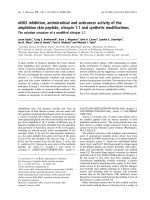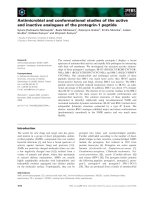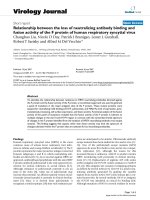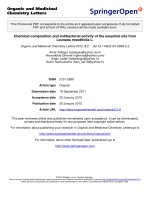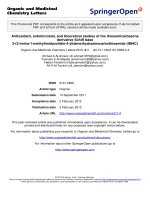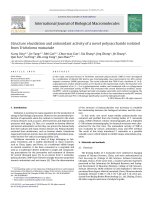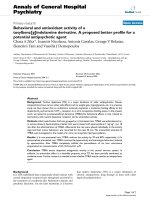Antimicrobial and antioxidant activity of bacterial endophytes isolated from leaves of the mangrove plant Rhizophora stylosa
Bạn đang xem bản rút gọn của tài liệu. Xem và tải ngay bản đầy đủ của tài liệu tại đây (305.8 KB, 9 trang )
TAP CHI SINH HOC 2019, 41(4): 91–99
DOI: 10.15625/0866-7160/v41n4.14675
ANTIMICROBIAL AND ANTIOXIDANT ACTIVITY
OF BACTERIAL ENDOPHYTES ISOLATED FROM LEAVES
OF THE MANGROVE PLANT Rhizophora stylosa
Ton That Huu Dat*, Phung Thi Thuy Oanh, Vu Thi Thanh Tam, Hoang Le Tuan Anh
Mientrung Institute for Scientific Research, VAST, Vietnam
Received 6 October 2019, accepted 27 December 2019
ABSTRACT
Mangroves are the most productive ecosystems and contain highly diverse plants and microbial
communities. Mangrove endophytes are proved to be a rich source of bioactive secondary
metabolites. The biological molecules produced by endophytes play an important role in
protection of mangrove plants against herbivores, insects as well as pathogens. The present study
aimed to isolate the endophytic bacteria from the mangrove plant Rhizophora stylosa and screen
antimicrobial and antioxidant activity of ethyl acetate extracts from the isolated endophytic
bacteria. A total of 64 endophytic bacterial strains from R. stylosa leaves were isolated, of which
ethyl acetate extracts of 14 isolated endophytic strains showed antimicrobial activity against at
least one of reference microorganisms Escherichia coli ATCC 25922, Pseudomonas aeruginosa
ATCC 25923, Bacillus subtilis ATCC 27212, Staphylococcus aureus ATCC 12222 and Candida
albicans ATCC 7754 with MIC values from 32 to 512 µg/ml. Among them, four strains showed
activity against one reference microorganism, five strains showed activity against two reference
microorganisms, four strains showed activity against three reference microorganisms, and one
strain showed activity against four reference microorganisms. Additionally, the ethyl acetate
extracts of 12 isolated endophytic bacteria showed ATBS and DPPH radical scavenging activity
with scavenging values from 36.3 ± 2.6% to 71.5 ± 6.6% and from 26.2 ± 3.3% to 57.4 ± 5.8%,
respectively. The identification of the five most active endophytic bacteria by 16S rRNA
sequences revealed that the endophytes belonged to four genera, including Bacillus,
Streptomyces, Pseudovibrio and Pseudomonas. The obtained results suggest that the endophytic
bacteria from mangrove plants are a promising reservoir of antimicrobial and antioxidant agents.
Keywords: Rhizophora stylosa, antimicrobial activity, antioxidant activity, endophytic bacteria,
mangroves.
Citation: Ton That Huu Dat, Phung Thi Thuy Oanh, Vu Thi Thanh Tam, Hoang Le Tuan Anh, 2019. Antimicrobial
and antioxidant activity of bacterial endophytes isolated from leaves of the mangrove plant Rhizophora stylosa. Tap
chi Sinh hoc (Academia Journal of Biology), 41(4): 91–99. />*Corresponding author email:
©2019 Vietnam Academy of Science and Technology (VAST)
91
Ton That Huu Dat et al.
INTRODUCTION
Endophytes were defined as “microbes
that colonize living, internal tissues of plants
without causing any immediate, overt
negative effects” (Stone et al., 2000). It is
reported that endophytes can be transmitted
over generations through the tissue of the
host, seed or plant propagules (Carroll, 1988).
Endophytic bacteria are able to prevent the
deleterious effects on certain pathogenic
organisms. These microbes function as a
biological defense for the plant against
phytopathogens by producing secondary
metabolites that inhibit phytopathogens or by
inducing host defense mechanisms (Alvin et
al., 2014). In addition, endophytes play
important roles in promotion of plant growth
by producing phytohormones (Tudzynski,
1997),
synthesizing
of
siderophores
(O'Sullivan & O'Gara, 1992), fixing nitrogen,
solubilizing minerals (Richardson et al.,
2009), suppressing ethylene (Glick et al.,
1998) or assisting phytoremediation (Ryan et
al., 2008).
Mangrove ecosystem is characterized by
periodic tidal flooding and provides unique
environmental characteristics for developing
diverse
groups
of
microorganisms
(Sivaramakrishnan et al., 2006, Thatoi et al.,
2013). Although the mangrove ecosystem is
rich in microbial diversity, the described
species have been less than 5%. Furthermore,
their ecological role and their technological
potential are poorly understood (Thatoi et al.,
2013). Interestingly, recent studies reveal that
the endophytic bacteria from mangrove plants
are an important source of bioactive secondary
metabolites. The secondary compounds derived
from endophytes of mangrove plants are
structurally diverse and pharmacologically
active. These known compounds from
mangrove plant endophytes include terpenes,
chromones, coumarins, polyketides, alkaloids,
and peptides (Kui-Wu et al., 2014; Xu, 2015;
Ancheeva et al., 2018). These compounds
exhibit a broad spectrum of biological
properties such as antioxidant, cytotoxic,
antifungal,
antibacterial,
α-glucosidase,
acetylcholinesterase, antivirus (Kui-Wu et al.,
92
2014; Xu, 2015; Ancheeva et al., 2018; Zhou et
al., 2018; Manganyi et al., 2019).
With the length of coastline up to 3260
km, coastal mangroves are among the most
productive and biologically important
ecosystems in Vietnam (e.g., habitat for
animal and vegetation species, medicinal
sources, carbon storage and coastal protection
from storm events). Regarding medicinal
potential
from
Vietnamese
mangrove
microorganisms, a few studies on the
antimicrobial
activity
of
mangrove
microorganisms have been reported (Hong &
Phuong, 2013; Dat et al., 2019). Herein, the
present study isolated and screened
antimicrobial and antioxidant bacterial
endophytes from the mangrove plant R.
stylosa for discovery of potential medicinal
sources
from
Vietnamese
mangrove
endophytic bacteria.
MATERIALS AND METHODS
Sample plant collection
The plant R. stylosa was collected in the
mangrove forest Canh Duong, Phu Loc, Thua
Thien Hue. The samples were contained in
sterile bags and transferred immediately to the
laboratory for isolation of bacterial
endophytes.
Isolation of endophytic bacteria from
leaves of R. stylosa
The fresh plant leaves were washed in
running water to remove soil particles. The
sample surface was then sterilized by
sequential immersion in 70% ethanol for 5
min and sodium hypochlorite for 10 min. The
samples then washed three times in sterile
distilled water to remove surface sterilizing
agents before being soaked in 10% sodium
bicarbonate. The samples were cut into small
pieces and placed on nutrient agar (Himedia)
and ISP medium No. 4 (Himedia) (Hoai et al.,
2018). The plates were incubated for 3−5 days
at 37°C for the growth of endophytic bacteria.
Representative bacterial isolates with different
colony morphotypes were selected, pure
cultured, and stored with 20% glycerol (v/v)
at -80°C.
Antimicrobial and antioxidant activity
Preparation of ethyl acetate extracts
The endophytic bacterial strains were
cultivated in 500 mL nutrient broth at 37°C,
150 rpm for 7 days. The fermentation broths
were extracted with ethyl acetate (5 times) and
then were evaporated under reduced pressure
to yield ethyl acetate extracts.
Screening antimicrobial activity of the
extracts
The ethyl acetate extracts of endophytic
bacteria were tested against five reference
microorganisms, including the Gram-positive
bacteria (S. aureus ATCC12222, B. subtilis
ATCC27212), the Gram-negative bacteria (P.
aeruginosa
ATCC25923,
E.
coli
ATCC25922) and the yeast C. albicans
ATCC7754. Antimicrobial activity of the
ethyl acetate extracts against reference
microorganisms was determined as minimum
inhibition concentration (MIC) values that
recorded by the microdilution method (Dat et
al., 2018). MIC value is the lowest
concentration of the extracts that completely
inhibits the growth of microorganisms.
Screening
extracts
antioxidant
activity
of
the
ABTS radical scavenging assay
The ABTS radical scavenging activity of
the extracts was determined by measuring the
decrease in absorbance of ABTS radical
solution in the presence of the extracts.
Briefly, two solutions ABTS 7 mM and
potassium persulfate 2.45 mM were mixed
and allowed to stand in the dark at room
temperature for 16 h before use in order to
produce ABTS radical solution. The ABTS
radical solution was then diluted with ethanol
to give an absorbance of 0.700 ± 0.02 at 734
nm. Ten microliters of each extract (500
µg/ml) were added to 190 µl of ABTS radical
solution in 96 well plates. The solution
incubated at room temperature for 10 min and
then the absorbance of the reaction was
recorded at 734 nm on a microplate reader.
Ascorbic acid was used as positive control.
The ABTS radical scavenging activity was
calculated as follow:
ABTS scavenging activity (%) = 100 × [(Ac –
As)/(Ac – Ab)]
Where: Ac was the absorbance of the control,
As was absorbance of the extract and Ab was
the absorbance of the blank.
DPPH radical scavenging assay
The DPPH radical scavenging activity of
the extracts was determined by measuring the
decrease in absorbance of DPPH radical
solution in the presence of the extracts.
Briefly, 10 µl of each extract (500 µg/ml) was
added to 190 µl of DPPH (0.1 mg/ml) in 96
well plates. The solution was mixed for 1 min
and incubated at room temperature for 30 min.
Then the absorbance of the reaction mixture
was recorded at 517 nm on a microplate
reader. Ascorbic acid was used as positive
control. The DPPH radical scavenging activity
was calculated as follow:
DPPH scavenging activity (%) = 100 × [(Ac –
As)/(Ac – Ab)]
Where: Ac was the absorbance of the control,
As was absorbance of the extract and Ab was
the absorbance of the blank.
Identification of the isolates by the 16S
rRNA sequence
The most potential bioactive isolates were
identified using 16S rRNA gene sequencing.
The 16S rRNA gene was amplified with
universal
primers:
27f
(5′AGAGTTTGATCCTGGCT CAG-3′) and
1492r (5′- GGTTACCTTGTTACGACTT-3′).
The PCR cycling parameters: an initial
denaturation at 94°C for 5 min followed by 30
cycles of denaturation at 94°C for 1 min,
annealing at 56°C for 50 s, amplification at
72°C for 1.5 min and a final extension at 72°C
for 7 min. The 16S rRNA gene sequencing
was carried by DNA Analyzer (ABI PRISM
3100, Applied Bioscience). The obtained
DNA sequences were removed poor quality
ends using BioEdit software v.2.7.5, and then
were blasted to sequences in the GenBank
database using the Blast search programme
( to find their
highest similarity sequences. The sequences
were aligned using the ClustalW algorithm.
93
Ton That Huu Dat et al.
The phylogenetic tree of 16S rRNA sequences
was created by the Neighbor-Joining
algorithm with 1000 bootstraps using MEGA
v.7.0.0.
RESULTS
Isolation of endophytic bacteria from
leaves of R. stylosa
From leaves of the plant R. stylosa
collected from mangrove forest Canh Duong,
Phu Loc, Thua Thien Hue, 64 endophytic
bacterial strains were isolated and pure
cultured, of which 39 strains were isolated
from NA medium and 25 strains were isolated
from ISP4 medium. Among them, 30
representative strains with different colony
morphotypes were selected for preparing ethyl
acetate extracts and screening antimicrobial
and antioxidant activity.
Antimicrobial activity of the ethyl acetate
extracts of the endophytic bacteria
Ethyl acetate extracts of 30 endophytic
bacteria were tested their antimicrobial
activity
against
five
pathogenic
microorganisms (E. coli ATCC 25922, P.
aeruginosa ATCC 25923, B. subtilis ATCC
27212, S. aureus ATCC 12222, and C.
albicans ATCC 7754). The tested results
showed that 14 out of 30 endophytic bacteria
exhibited antimicrobial activity against at
least one reference microorganism with MIC
values ranging from 32 to 512 µg/mL (Table
1). Among them, 4 strains showed activity
against one reference microorganism, 5 strains
showed activity against two reference
microorganisms, 4 strains showed activity
against 3 reference microorganisms, and only
one strain showed activity against 4 reference
microorganisms. It was found that isolated
strains were more active towards Grampositive bacteria (14 strains) than Gramnegative bacteria (11 strains), whereas number
of strains displaying activity against yeast C.
albicans was lowest (5 strains). Frequencies
of the antimicrobial activities against the
microbial pathogens were as follows: B.
subtilis (23.3%), S. aureus (23.3%), E. coli
(20.0%), P. aeruginosa (16.7%), C. albicans
(16.7%).
Table 1. Antimicrobial activity (µg/mL) of ethyl acetate extracts from isolated endophytes
Gram-positive
Gram-negative
Yeast
Isolates
B. subtilis
S. aureus
P. aeruginosa
E. coli
C. albicans
ATCC 27212 ATCC 12222 ATCC 25923 ATCC 25922 ATCC 7754
RSL-N1
64
256
128
RSL-N3
256
RSL-I4
32
64
256
RSL-I8
128
RSL-N13
256
128
32
64
RSL-N14
64
64
RSL-I16
64
64
32
RSL-N19
512
32
RSL-N20
128
RSL-I23
32
512
RSL-N24
64
512
32
RSL-N26
128
64
RSL-N29
128
256
RSL-I30
64
-
94
Antimicrobial and antioxidant activity
Antioxidant activity of the ethyl acetate
extracts of the endophytic bacteria
The antioxidant activity of ethyl acetate
extracts of the endophytic bacteria was
determined by the ABTS and DPPH radical
scavenging assays (Figure 1). The ABTS and
DPPH radical scavenging assays showed the
extracts of 12 endophytic bacteria exhibited
ABTS and DPPH radical scavenging activity
with scavenging values from 36.3 ± 2.6% to
71.5 ± 6.6% and 26.2 ± 3.3% to 57.4 ± 5.8%,
respectively. Among them, the ethyl acetate
extracts of five bacterial endophytes RSL-N1,
RSL-I4, RSL-N13, RSL-I16, RSL-N24
showed the scavenging activity more than
50%. The positive control (ascorbic acid)
showed ABTS and DPPH radical scavenging
activity with scavenging values of 89.2 ±
6.5% and 83.4 ± 6.1%, respectively.
Figure 1. DPPH and ABTS radical scavenging activity of the ethyl acetate extracts
Molecular identification of active bacterial
endophytes
The 16S rRNA genes of five endophytic
bacteria with highly antimicrobial and
antioxidant activities were amplified and
sequenced to identify their taxa. The 16S
rRNA sequences of strains were high
similarity (99 - 100%) to that of bacteria on
GenBank (Table 2). The phylogenetic analysis
revealed that five endophytic bacteria
belonged to 4 genera, including Bacillus,
Pseudovibrio, Pseudomonas and Streptomyces
(Figure 2).
Table 2. The closest sequences of 16S rRNA sequences of isolates obtained in NCBI for
Isolates
Media
Closest homologs
Similarity (%)
RSL-N1
NA
Bacillus pumilus CE92, MK618603
100
RSL-I4
ISP4
Bacillus licheniformis MSWS30, KX785167
99.9
RSL-N13
NA
Streptomyces viridis BK199, NR_117083
99.8
RSL-I16
ISP4
Pseudovibrio japonicus WSF2, NR_041391
99.6
RSL-N24
NA
Pseudomonas synxantha IAM 12356, NR_043425
99.7
95
Ton That Huu Dat et al.
Figure 2. Phylogenetic tree based on 16S rRNA gene sequences of isolates and their closest
sequences derived from NCBI
DISCUSSION
Mangrove plants are considered as an
ecological niche for diverse endophytic
microorganisms and are potential sources of
bioactive compounds. The aim of this study
was to isolate endophytic bacteria from the
mangrove plant R. stylosa and screen
antimicrobial and antioxidant activities of
ethyl acetate extracts of the isolated
endophytic bacteria. The antimicrobial and
antioxidant assays in our study revealed
96
endophytic bacteria of R. stylosa as potential
producers of antimicrobial and antioxidant
compounds. Among ethyl acetate extracts of
30 isolated endophytic bacteria, 14 extracts
showed antimicrobial activity and 12 extracts
showed antioxidant activity. Previous studies
have reported that endophytic microorganisms
from mangrove plants exhibit a wide range of
biological activity, including antimicrobial
and antioxidant activities. In respect of the
antimicrobial activity, Fareza et al. (2018)
isolated
two
endophytic
fungi
Antimicrobial and antioxidant activity
Neopestalotiopsis sp. and Peniophora lycii
from leaves of R. mucronata. The extracts
from two isolated fungi showed antimicrobial
activity against E. coli ATCC 25922 and S.
aureus ATCC 25923 with MIC values from
125 to 500 µg/ml. Handayani et al. (2017)
isolated 12 endophytic fungi from mangrove
plant Sonneratia griffithii. These fungi
belonged to two genera Aspergillus and
Candida. Among them, the extracts of 10
endophytic fungi exhibited antibacterial
activity against E. coli and S. aureus with
zone inhibition from 8.0 to 15.75 mm at a
concentration of 10 mg/ml extract in DMSO.
Eldeen et al. (2014) also isolated 33
endophytic bacteria from five mangrove
plants Avicennia lanata, R. mucronata, R.
apiculata, Sonneratia caseolaris, and
Xylocarpus moluccensis. Of these, 18 isolated
bacteria exhibited antibacterial activity against
B. cereus, S. aureus, E. coli, Salmonella
typhimurium with MIC values of 19-250
µg/ml. The identification of isolated bacteria
revealed that they belonged to genera Bacillus
and Staphylococcus. In another study, Nia et
al (2017) isolated 12 endophytic bacteria from
two mangrove plants R. apiculata and
Bruguiera gymnorrizha, of which, two fungi
Penicillin spp. showed antibacterial activity
against Klebsiella pneumonia (Nia et al.,
2017). In regard of the antioxidant activity,
Rahmawati et al. (2019) isolated six fungi and
three bacteria from two mangrove plants
Avicennia marina and Xylocarpus granatum.
Of these, six fungi and two bacteria showed
DPPH radical scavenging activity with IC50
values from 1 - 19 ppm. Zhoe et al. (2018)
isolated 225 fungal strains from two
mangrove plant R. stylosa and R. mucronata.
Antioxidant assays revealed that the crude
extracts of 40 isolated endophytic fungi
showed the DPPH and ABTS radical
scavenging activities with IC50 values from
0.33 ± 0.02 to 14.36 ± 0.68 mg/ml. Obtained
results in our study and the previous studies
show that the endophytic microorganisms
from mangrove plants are promising sources
of antimicrobial and antioxidant agents for
pharmaceutical applications.
CONCLUSION
The present study isolated endophytic
bacteria from the mangrove plant R. stylosa
and screened antimicrobial and antioxidant
activity of ethyl acetate extracts from the
isolated endophytic bacteria. From leaves of
R. stylosa, 64 endophytic bacterial strains
were isolated, of which the ethyl acetate
extracts of 14 isolated endophytic strains
showed antimicrobial activity against at least
one of reference microorganisms with MIC
values from 32 to 512 µg/ml. Furthermore, the
ethyl acetate extracts of 12 isolated
endophytic bacteria showed ABTS and DPPH
radical scavenging activity with scavenging
values from 36.3 ± 2.6% to 71.5 ± 6.6% and
26.2 ± 3.3% to 57.4 ± 5.8%, respectively. The
identification of five promising endophytic
bacteria by 16S rRNA sequences revealed that
the endophytes to 4 genera, including
Bacillus,
Streptomyces,
Pseudovibrio,
Pseudomonas. The obtained results suggest
that mangrove endophytes are a potential
source of antimicrobial and antioxidant
agents.
Acknowledgements: This work was supported
by Vietnam Academy of Science and
Technology
under
grant
number:
ĐL0000.02/19-20.
REFERENCES
Alvin A., Miller K. I., Neilan B. A., 2014.
Exploring the potential of endophytes
from medicinal plants as sources of
antimycobacterial
compounds.
Microbiological Research, 169: 483–495.
Ancheeva E., Daletos G., Proksch P., 2018.
Lead compounds from mangroveassociated microorganisms. Marine drugs,
16: 319.
Carroll G., 1988. Fungal endophytes in stems
and leaves: from latent pathogen to
mutualistic symbiont. Ecology, 69: 2–9.
Dat T. T. H., Hong T. T., Dung T. T. K,
Hoa N. P., Cuong P. V., Binh P. T., Dat
N. T., Cuc N. T. K., 2018. Screening of
antimicrobial
producing
bacteria
associated with sponge and isolation of
97
Ton That Huu Dat et al.
secondary metabolites from selected
strain.
Proceedings
of
National
Conference on Biotechnology 2018.
Publishing House for Natural Science
and Technology, Ha Noi, Vietnam,
pp. 774–779.
Dat T. T. H., Oanh P. T. T., Tam V. T. T.,
Anh H. L. T., 2019. Antimicrobial activity
of bacteria isolated from the coastal
mangrove sediment in Thua Thien Hue.
Proceedings of National Scientific Forum
2019: Marine Biology and Sustainable
Development. Publishing House of
Natural Science and Technology, Hai
Phong, Vietnam, pp. 971–980.
Eldeen I., 2014. Isolation of 12 bacterial
endophytes from some mangrove plants
and determination of antimicrobial
properties of the isolates and the plant
extracts.
International
Journal
of
Phytomedicine, 6: 425–432.
Fareza M. S., Choironi N. A., Harwoko H.,
Sunarto S., 2018. Antibacterial activity of
two isolated endophytic fungi extracts
associated with Indonesian mangrove
plant
Rhizophora
mucronata.
Pharmaciana, 8: 169–175.
Glick B. R., Penrose D. M., Li J., 1998. A
model for the lowering of plant ethylene
concentrations by plant growth-promoting
bacteria. Journal of Theoretical Biology,
190: 63–68.
Handayani D., Rivai H., Hutabarat M.,
Rasyid R., 2017. Antibacterial activity of
endophytic fungi isolated from mangrove
plant Sonneratia griffithii Kurz. Journal
of Applied Pharmaceutical Science, 7:
209–212.
Hoai P. T. T., Dat T. T. H., Hong T. T., Cuc
N. T. K., Man T. D., Cuong P. V., 2018.
Isolation and selection of indigenous
antifungal
microorganisms
against
pathogenic fungi of pepper plant in Tay
Nguyen.
Vietnam
Journal
of
Biotechnology, 16: 385–392.
Hong H. T., Phuong N. N., 2013. The
isolation and selection of actinomycete
98
species from Can Gio tropical swamp for
their antifungal feature against Fusarium
sp. Journal of Science, Ho Chi Minh City
University of Education, 51: 59–71.
Kui-Wu W., Shi-Wei W., Bin W0, Ji-Guang
W., 2014. Bioactive natural compounds
from the mangrove endophytic fungi.
Mini-Reviews in Medicinal Chemistry, 14:
370–391.
Manganyi M. C., Tchatchouang C. D. K.,
Regnier T., Bezuidenhout C. C., Ateba C.
N., 2019. Bioactive compound produced
by endophytic fungi isolated from
Pelargonium sidoides against selected
bacteria
of
clinical
importance.
Mycobiology, 47: 335–339.
Nia R., Mia M., Oktapiana K., 2017.
Antibacterial activity test of endophytic
fungus
from
mangrove
plant
(Rhizophora
apiculata
L.)
and
(Bruguiera gymnorrizha (L.) Lamk.)
against Klebsiella pneumoniae ATCC
700603.
ICSAFS
Conference
Proceedings of 2nd International
Conference on Sustainable Agriculture
and Food Security: A Comprehensive
Approach. KnE Life Sciences, West
Java, Indonesia, pp. 146–157.
O'Sullivan D. J., O'Gara F., 1992. Traits of
fluorescent Pseudomonas spp. involved in
suppression of plant root pathogens.
Microbiological Reviews, 56: 662–676.
Rahmawati S. I., Izzati F. N., Hapsari Y.,
Septiana E., Rachman F., Bustanussalam,
Simanjuntak P., 2019. Endophytic
microbes and antioxidant activities of
secondary metabolites from mangroves
Avicennia marina and Xylocarpus
granatum. IOP Conference Series: Earth
and Environmental Science, 278: 012065.
Richardson A. E., Barea J. M., McNeill A.
M.,
Prigent-Combaret
C.,
2009.
Acquisition of phosphorus and nitrogen in
the rhizosphere and plant growth
promotion by microorganisms. Plant and
Soil, 321: 305–339.
Antimicrobial and antioxidant activity
Ryan R. P., Germaine K., Franks A., Ryan D.
J., Dowling D. N., 2008. Bacterial
endophytes: recent developments and
applications. FEMS Microbiology Letters,
278: 1–9.
Sivaramakrishnan S., Gangadharan D.,
Nampoothiri K., Soccol C., Pandey A.,
2006. α-amylases from microbial sources–
an overview on recent developments.
Food Technology and Biotechnology, 44:
173–184.
Stone J., Bacon C., White J., 2000. An
overview of endophytic microbes:
endophytism defined. In: Bacon CW &
White J (Eds) Microbial endophytes, CRC
Press, Boca Raton, Florida, USA, pp. 3–29.
Thatoi H., Behera B. C., Mishra R. R., Dutta
S.
K.,
2013.
Biodiversity
and
biotechnological
potential
of
microorganisms
from
mangrove
ecosystems: a review. Annals of
Microbiology, 63: 1–19.
Tudzynski B., 1997. Fungal phytohormones in
pathogenic and mutualistic associations.
In: Carroll GC & Tudzynski P (Eds) Plant
Relationships: Part A, Springer Berlin
Heidelberg, Berlin, Heidelberg, Germany,
pp. 167–184.
Xu J., 2015. Bioactive natural products
derived
from
mangrove-associated
microbes. RSC Advances, 5: 841–892.
Zhou J., Diao X., Wang T., Chen G., Lin Q.,
Yang X., Xu J., 2018. Phylogenetic
diversity and antioxidant activities of
culturable fungal endophytes associated
with the mangrove species Rhizophora
stylosa and R. mucronata in the South
China Sea. PloS one, 13: e0197359.
99
